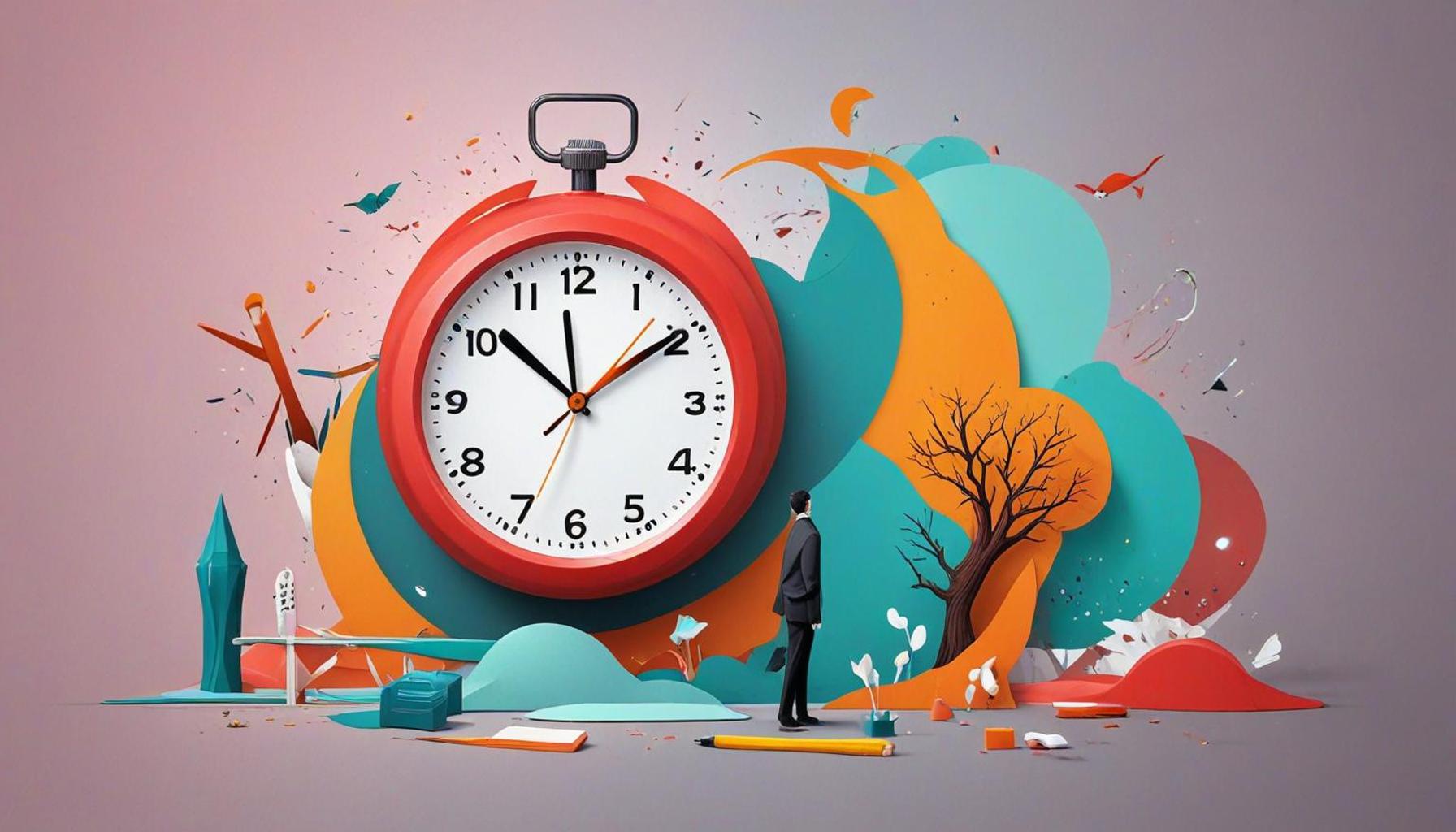Simplifying Decision-Making: The Influence of Minimalism on Time Management and Personal Productivity

Understanding Minimalism in Decision-Making
In contemporary society, where consumer choices are virtually limitless, people often experience what is known as the paradox of choice. This phenomenon suggests that while having options can feel liberating, it frequently leads to anxiety and indecision. However, the principles of minimalism provide a pathway to enhance clarity and purpose in decision-making. By selectively focusing on what truly matters, individuals can cultivate a sense of peace and efficiency in their daily lives.
Reducing Distractions
One of the core tenets of minimalism is creating a clutter-free environment. This doesn’t just pertain to physical items—it’s about removing anything that distracts from our core objectives. Studies have shown that a tidy workspace can significantly improve concentration and productivity. For instance, a study from the Princeton University Neuroscience Institute found that clutter can negatively affect a person’s ability to focus and process information. By surrounding ourselves with only what is necessary, we allow our minds to function optimally, paving the way for enhanced creativity and problem-solving.
Fewer Choices, Faster Decisions
Minimalism advocates for the idea of limiting options. Too many choices can lead to decision fatigue, where the quality of one’s decisions deteriorates after a long session of decision-making. Consider the example of wardrobe planning; by adopting a capsule wardrobe—a minimalist approach where a few versatile pieces are combined—it becomes easier to choose outfits daily. Not only does this save time, but it also alleviates stress and enhances confidence in decision-making. Similarly, in areas like meal planning, a simplified menu can streamline grocery shopping and cooking, making it easier and more enjoyable.
The Power of Mindfulness
Minimalism encourages mindfulness—a practice of being fully present and engaged with the task at hand. By prioritizing essential tasks, individuals can focus on what genuinely contributes to their personal and professional goals. For instance, implementing techniques like the Pomodoro Technique, which involves working in focused bursts followed by short breaks, can help align one’s work with minimalist principles. This method not only fosters efficiency but also encourages regular reflection on how one spends their time, promoting a more intentional approach to productivity.
In embracing minimalism, individuals often report increased satisfaction and a sense of accomplishment in their endeavors. By stripping away the superfluous, they frequently find that time management transforms from a daunting challenge into a well-organized ally. This shift has profound implications for personal effectiveness, as it allows for a more meaningful engagement with both work and leisure.

As we delve deeper into the practical applications of minimalism within decision-making, we will uncover various tools and techniques designed to support this mindset. From digital decluttering of one’s online presence to establishing time management frameworks that prioritize essential tasks, these strategies aim to inspire a living space and mindset that favor a more productive, fulfilling life.
DISCOVER MORE: Click here to enhance your time management skills
The Impact of Minimalism on Time Efficiency
When examining the intersection of minimalism and time management, it is essential to understand how reducing excess can lead to profound improvements in personal productivity. The theory that “less is more” aligns seamlessly with the challenges many face in today’s fast-paced world, where the average worker switches tasks every three minutes, according to a study by the American Psychological Association. This constant toggling strains mental resources, making it increasingly difficult to maintain focus and execute tasks efficiently.
Streamlining Priorities
One of the most effective ways minimalism enhances decision-making is by urging individuals to streamline their priorities. Simplifying both personal and professional commitments allows for a clearer path toward achieving goals. By using tools such as the Eisenhower Matrix, individuals can prioritize tasks based on urgency and importance, effectively categorizing responsibilities into four quadrants:
- Urgent and Important: Tasks that need immediate attention.
- Important but Not Urgent: Tasks that require planning but are not immediate.
- Urgent but Not Important: Tasks that can be delegated.
- Neither Urgent nor Important: Tasks to consider eliminating altogether.
Implementing this method not only enhances clarity but also minimizes the time spent deciding on what to do next. This direct approach can foster greater engagement with essential tasks and ultimately lead to increased output in both work and personal realms.
Embracing Digital Minimalism
With technology being an integral part of our daily routines, digital minimalism helps to enhance productivity significantly. It involves curating your digital life to exclude unnecessary notifications, apps, and devices that distract from core tasks. Research by the journal “Information Systems Research” indicates that reducing unnecessary digital clutter leads to enhanced focus and improved cognitive performance. This practice can manifest itself through strategies such as:
- Unsubscribing from irrelevant emails to reduce your inbox clutter.
- Limiting time spent on social media platforms that do not add value.
- Utilizing productivity applications that help prioritize and track important tasks.
By embracing digital minimalism, individuals create an environment that encourages productivity rather than distraction. This alignment towards what truly matters acts as a catalyst for better time management and facilitates a shift in mindset that prioritizes quality over quantity in every decision made.
In the quest for efficiency, minimalism provides a refreshing framework for reassessing what is necessary and what can be let go. As we continue to explore the integral components of minimalism in decision-making, we will delve into specific actionable strategies that transform the way individuals manage their time and enhance their productivity in remarkably efficient ways.
| Advantage | Description |
|---|---|
| Clarity in Decision-Making | Minimalism fosters a clear mindset, which enhances decision-making by reducing clutter and unnecessary options. |
| Increased Focus | By minimizing distractions, personal productivity is enhanced, allowing for an intense focus on key tasks and priorities. |
In an era where decisions are often overwhelmed by information, minimalism offers a refreshing approach to reclaiming clarity. Embracing a minimalist lifestyle not only simplifies the environment but also significantly boosts time management. When faced with fewer choices, individuals are more likely to make decisions quickly and confidently. Consider this: a streamlined workspace can lead to less time spent looking for materials and more time dedicated to pivotal tasks.Furthermore, increased focus is a major benefit of minimalism. When distractions are minimized, tasks can be completed more efficiently, reinforcing the cycle of productivity. For instance, decluttering your desk can have an immediate effect on both mental clarity and overall work quality. By honing in on what’s truly important, one can elevate personal effectiveness, making the most of their time. Therefore, the influence of minimalism reaches beyond aesthetics; it actively transforms how we manage our time and productivity in profound ways.
DIVE DEEPER: Click here to unlock effective strategies
The Role of Decluttering in Enhancing Focus
Another critical aspect of minimalism that plays a vital role in bolstering personal productivity is decluttering. The physical environment significantly influences our mental state and ability to concentrate. According to a study published in the “Journal of Environmental Psychology,” individuals in cluttered spaces report higher levels of stress and lower levels of focus. By removing distracting items and organizing workspaces, individuals can create an atmosphere conducive to enhanced productivity.
Physical Decluttering Practices
To effectively declutter one’s workspace, minimalism recommends practical, actionable strategies that yield immediate results. For example:
- Regularly Scheduled Cleanouts: Setting aside time each week to organize and remove unnecessary items can keep the workspace serene and focused. This regular habit promotes a mindset of continuous evaluation of what is actually needed.
- Adhering to the One-In-One-Out Rule: For every new item introduced into the workspace, an old item should be removed. This rule helps maintain a minimalist approach by preventing accumulation.
- Utilizing Storage Solutions: Investing in smart storage solutions like organizers and trays can help keep essential items easily accessible while minimizing visual clutter.
These decluttering practices not only facilitate a more visually appealing workspace but also serve to keep the mind free of unnecessary distractions, ultimately leading to increased productivity.
Emotional Minimalism for Enhanced Clarity
Minimalism also extends into the realm of emotional and mental clarity, often termed emotional minimalism. This concept encourages individuals to let go of emotional baggage, stressful commitments, and relationships that drain energy. Research published in “Psychological Review” indicates that individuals who practice emotional minimalism enjoy improved mental clarity and decision-making abilities.
Concrete tactics for fostering emotional minimalism include:
- Journaling: Maintaining a daily journal to reflect on emotions and commitments can help identify what is worth keeping and what needs to be let go. This reflective practice helps draw clear lines on how time and energy should be allocated.
- Setting Personal Boundaries: Learning to say no can be empowering, allowing individuals to focus their time and energy on tasks and relationships that align with their values and goals.
- Mindfulness Practices: Engaging in mindfulness through meditation or breathwork can cultivate mental clarity by reducing emotional noise, leading to more thoughtful decision-making.
By embracing emotional minimalism, individuals can distill their priorities to reflect genuine importance, leading to improved time management and productivity.
As we delve deeper into the principles of minimalism, it becomes evident that the practice transcends physical spaces and influences our emotional landscapes. Understanding how to cultivate both physical and emotional minimalism can lead to a more fulfilling, productive life, making space for the decisions that truly matter.
DISCOVER MORE: Click here to learn how financial simplification can enhance your well-being</
Conclusion
In a world overflowing with choices and distractions, minimalism emerges as a powerful ally for anyone striving to optimize time management and boost personal productivity. As explored throughout this article, the principles of minimalism palpably influence not only our physical environments but also our emotional landscapes. By implementing simple yet effective decluttering strategies, individuals can create a workspace that fosters concentration and reduces stress, setting the stage for better decision-making.
Moreover, delving into the concept of emotional minimalism opens new avenues for clarity and intentionality in our lives. By jettisoning excess emotional baggage, establishing firm boundaries, and embracing mindfulness, we can sharpen our focus on what truly matters. This holistic approach leads to a profound understanding of our priorities, aligning our time and energy with our core values.
The journey toward minimalism isn’t merely about reducing physical possessions; it represents a comprehensive transformation that equips individuals with the tools to navigate the complexities of modern life. Whether through regular cleanouts or reflective journaling, the path to simplification holds the potential for lasting impact on our decision-making processes.
As we continue to embrace this philosophy, it becomes clear that adopting a minimalist mindset can significantly streamline our lives, making room for creativity, innovation, and the decisions that lead to more fulfilling experiences. By consciously choosing to prioritize less, we unlock the capacity to accomplish more—both personally and professionally.



